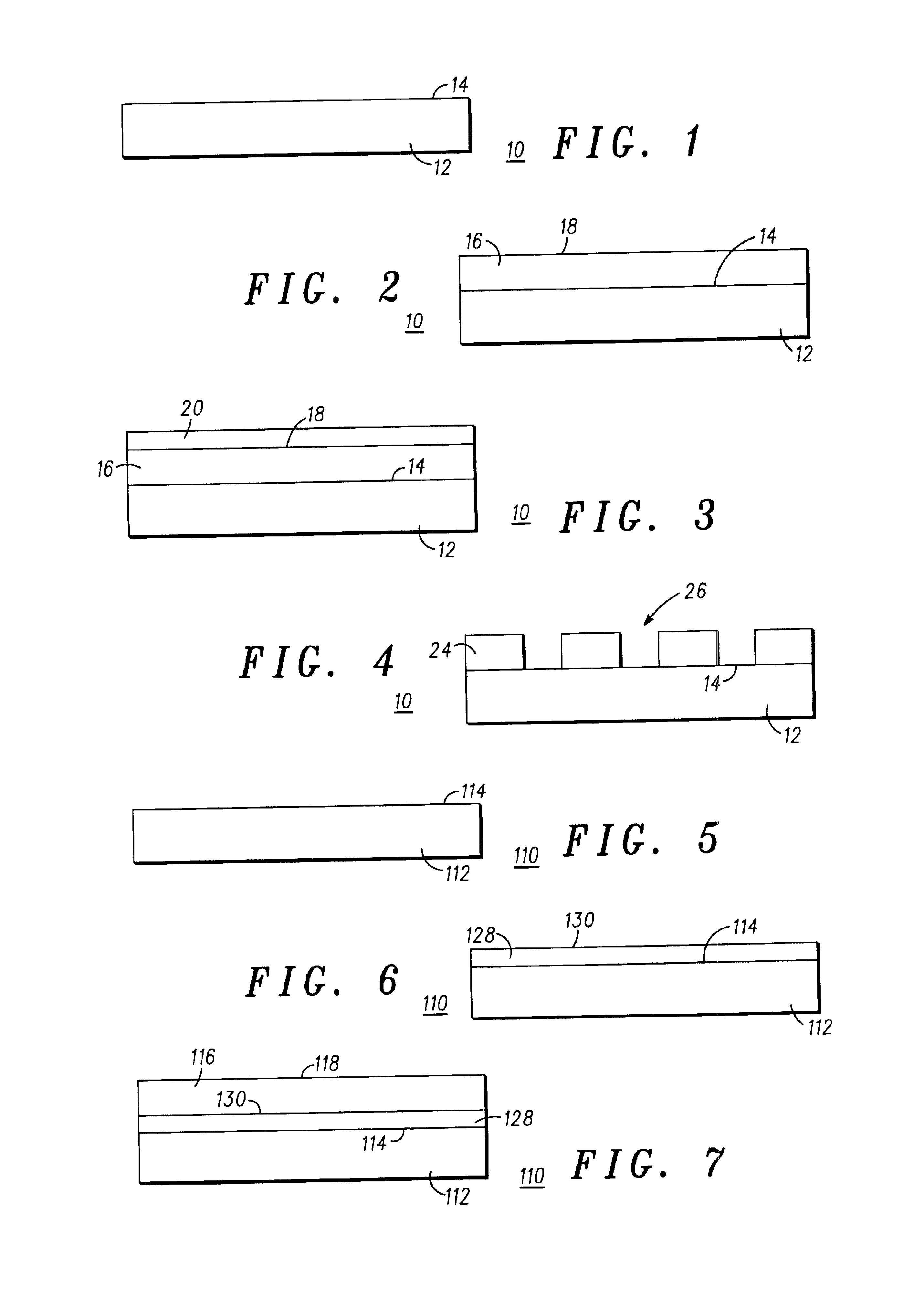Lithographic template and method of formation and use
a template and lithographic technology, applied in the field of lithographic templates, can solve the problems of the number of required steps for fabricating the template, masking and etching steps, and the conventional resist, masking and etching process
- Summary
- Abstract
- Description
- Claims
- Application Information
AI Technical Summary
Benefits of technology
Problems solved by technology
Method used
Image
Examples
first embodiment
[0022]Referring to FIGS. 1-13, illustrated in cross-sectional views, are a plurality of process steps for fabricating a lithographic template according to the preferred embodiments of the present invention. Referring more specifically to FIGS. 1-4, illustrated are the steps in the process of fabricating the lithographic template according to the present invention.
[0023]Referring now to FIG. 1, illustrated is a first step in the process of fabricating a lithographic template 10 according to the present invention. Illustrated is substrate 12, having a surface 14. Substrate 12 is disclosed as being comprised of a transparent or semi-transparent material, such as a quartz material, a polycarbonate material, a pyrex material, a calcium fluoride (CaF2) material, a magnesium fluoride material (MgF2), or any other similar type of material, that is transparent or semi-transparent to light.
[0024]Referring now to FIG. 2, illustrated is substrate 12, having deposited thereon uppermost surface 1...
second embodiment
[0033]Referring now to FIGS. 5-9, illustrated are the steps in the process of fabricating the lithographic template according to the present invention in which a separate contrast enhancement layer (discussed presently) is included, sandwiched between substrate 12 and patterning layer 16. More specifically, referring to FIG. 5, illustrated is a first step In the process of fabricating a lithographic template 110 according to the present invention. Illustrated is substrate 112, having a surface 114. Substrate 112 is disclosed as being comprised of a transparent or semi-transparent material, such as a quartz material, a polycarbonate material, a pyrex material, a calcium fluoride (CaF2) material, a magnesium fluoride material (MgF2), or any other similar type of material, that is transparent to light.
[0034]Referring now to FIG. 6, illustrated is substrate 112, having deposited thereon surface 114, a contrast enhancement layer 128. Contrast enhancement layer 128 is disclosed as being f...
third embodiment
[0041]Referring now to FIGS. 10-13, illustrated are the steps in the process of fabricating the lithographic template according to the present invention. More specifically, referring now to FIG. 10, illustrated is a first step in the process of fabricating a lithographic template 210 according to the present invention. Illustrated is substrate 212, having a surface 214. Substrate 212 is disclosed as being comprised of a transparent or semi-transparent material, such as a quartz material, a polycarbonate material, a pyrex material, a calcium fluoride (CaF2) material, a magnesium fluoride material (MgF2), or any other similar type of material, that is transparent or semi-transparent to light.
[0042]Referring now to FIG. 11, illustrated is substrate 212, having deposited thereon surface 214 and a charge dissipation layer 220. Charge dissipation layer 220 is disclosed as being formed of a transparent or semi-transparent conducting oxide. Examples of transparent or semi-transparent conduc...
PUM
| Property | Measurement | Unit |
|---|---|---|
| thick | aaaaa | aaaaa |
| thickness | aaaaa | aaaaa |
| thickness | aaaaa | aaaaa |
Abstract
Description
Claims
Application Information
 Login to View More
Login to View More - R&D
- Intellectual Property
- Life Sciences
- Materials
- Tech Scout
- Unparalleled Data Quality
- Higher Quality Content
- 60% Fewer Hallucinations
Browse by: Latest US Patents, China's latest patents, Technical Efficacy Thesaurus, Application Domain, Technology Topic, Popular Technical Reports.
© 2025 PatSnap. All rights reserved.Legal|Privacy policy|Modern Slavery Act Transparency Statement|Sitemap|About US| Contact US: help@patsnap.com



